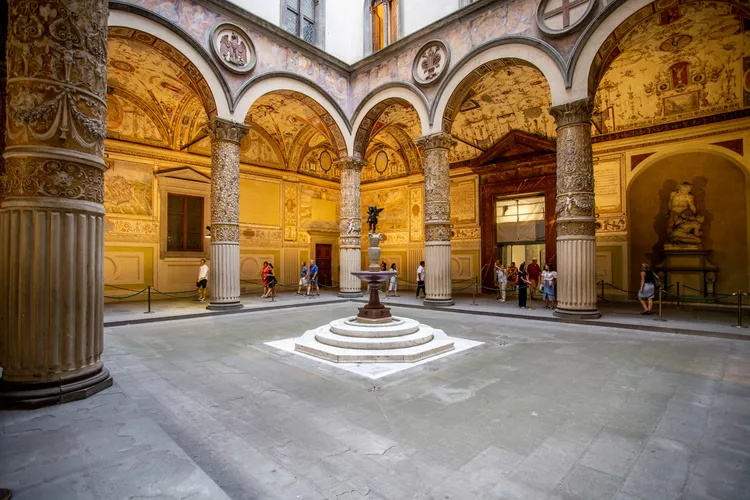Summary of Highlights in Palazzo Vecchio
The Palazzo Vecchio is one of the most important and famous buildings in Florence. While the building still functions as Florence’s city hall, much of the Palazzo Vecchio is a museum. Here are the key highlights for your visit to the Palazzo Vecchio in Florence.
What to See on the Ground Floor
Entrance: The entrance to the Palazzo Vecchio is flanked by a copy of Michelangelo’s David (the original is in the Accademia) and the statue of Hercules and Cacus by Baccio Bandinelli. Above the door is a gorgeous frontispiece set against a blue background, flanked by two gilded lions.
Cortile di Michelozzo: Designed by the artist Michelozzo, the harmonious inner courtyard features arcading with gilded columns, a copy of a fountain by Andrea del Verrocchio (the original is inside the palace), and walls adorned with various city scenes.
What to See on the Second Floor (1st Floor European)
Salone dei Cinquecento: This grand “Room of the Five Hundred” once hosted the Council of the Five Hundred, a governing body established by Savonarola during his brief tenure in power. The long room is vividly decorated with works by Giorgio Vasari, who oversaw its redesign in the mid-16th century. It boasts an ornate, coffered, and painted ceiling illustrating the life of Cosimo I de’ Medici, while the walls are adorned with large depictions of Florence’s victories over Siena and Pisa.
Initially, renowned artists Leonardo da Vinci and Michelangelo were commissioned to create works for this room, but those frescoes have unfortunately been “lost.” It is believed that Leonardo’s “Battle of Anghiari” frescos remain hidden beneath one wall. Michelangelo’s “Battle of Cascina” was never realized on the walls, as he was called to Rome to work on the Sistine Chapel before beginning work here. However, his statue “Genius of Victory,” located in a niche at the southern end of the room, is definitely worth a view.
The Studiolo: This opulent study, designed by Vasari for Francesco I de’ Medici, the Grand Duke of Tuscany, is adorned from floor to ceiling with Mannerist paintings by Vasari and other prominent artists such as Alessandro Allori, Jacopo Coppi, Giovanni Battista Naldini, and Santi di Tito.
What to See on the Third Floor (2nd Floor European)
Loggia del Saturno: This spacious room features an ornate ceiling painted by Giovanni Stradano and is celebrated for its breathtaking views over the Arno Valley.
The Sala dell’Udienza and the Sala dei Gigli: These two rooms showcase some of the oldest interior decoration elements in Palazzo Vecchio, including a coffered ceiling by Giuliano da Maiano and frescoes of St. Zenobius by Domenico Ghirlandaio. The stunning Sala dei Gigli (Lily Room) is named for the patterned gold-on-blue fleur-de-lys — the symbol of Florence — displayed on its walls. Another notable treasure in this room is Donatello’s statue of Judith and Holofernes.
Additional rooms worth visiting in Palazzo Vecchio include the Quartiere degli Elementi, also designed by Vasari; the Sala Delle Carte Geographiche, featuring maps and globes; and the Quartiere del Mezzanino, which houses the Charles Loeser collection of Middle Ages and Renaissance paintings. During the summer months, the museum often organizes small tours of the parapets on the exterior of the palace. If you’re visiting during this period, consider inquiring at the ticket desk about available tours and tickets.
Location and Visiting Hours
Palazzo Vecchio Location: Piazza della Signoria
Visiting Hours: Fridays to Wednesdays, from 9 a.m. to 7 p.m.; Thursdays from 9 a.m. to 2 p.m.; closed on January 1, Easter, May 1, August 15, and December 25.
Visiting Information: For more details, please visit the Palazzo Vecchio website or call (0039) 055-2768-325.
Palazzo Vecchio Tours: Select Italy offers two distinct tours; the Palazzo Vecchio Guided Tour focuses on art and history, while the Secret Routes Tour allows exploration of hidden rooms and the attic, in addition to the most renowned rooms. There is also a fresco painting workshop available.




